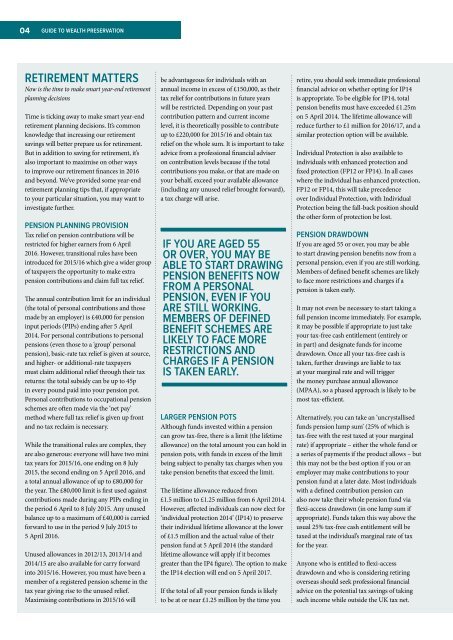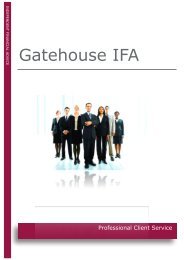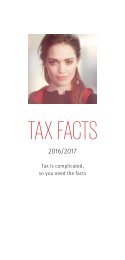wealthguide
You also want an ePaper? Increase the reach of your titles
YUMPU automatically turns print PDFs into web optimized ePapers that Google loves.
04<br />
GUIDE TO WEALTH PRESERVATION<br />
RETIREMENT MATTERS<br />
Now is the time to make smart year-end retirement<br />
planning decisions<br />
Time is ticking away to make smart year-end<br />
retirement planning decisions. It’s common<br />
knowledge that increasing our retirement<br />
savings will better prepare us for retirement.<br />
But in addition to saving for retirement, it’s<br />
also important to maximise on other ways<br />
to improve our retirement finances in 2016<br />
and beyond. We’ve provided some year-end<br />
retirement planning tips that, if appropriate<br />
to your particular situation, you may want to<br />
investigate further.<br />
PENSION PLANNING PROVISION<br />
Tax relief on pension contributions will be<br />
restricted for higher earners from 6 April<br />
2016. However, transitional rules have been<br />
introduced for 2015/16 which give a wider group<br />
of taxpayers the opportunity to make extra<br />
pension contributions and claim full tax relief.<br />
The annual contribution limit for an individual<br />
(the total of personal contributions and those<br />
made by an employer) is £40,000 for pension<br />
input periods (PIPs) ending after 5 April<br />
2014. For personal contributions to personal<br />
pensions (even those to a ‘group’ personal<br />
pension), basic-rate tax relief is given at source,<br />
and higher- or additional-rate taxpayers<br />
must claim additional relief through their tax<br />
returns: the total subsidy can be up to 45p<br />
in every pound paid into your pension pot.<br />
Personal contributions to occupational pension<br />
schemes are often made via the ‘net pay’<br />
method where full tax relief is given up front<br />
and no tax reclaim is necessary.<br />
While the transitional rules are complex, they<br />
are also generous: everyone will have two mini<br />
tax years for 2015/16, one ending on 8 July<br />
2015, the second ending on 5 April 2016, and<br />
a total annual allowance of up to £80,000 for<br />
the year. The £80,000 limit is first used against<br />
contributions made during any PIPs ending in<br />
the period 6 April to 8 July 2015. Any unused<br />
balance up to a maximum of £40,000 is carried<br />
forward to use in the period 9 July 2015 to<br />
5 April 2016.<br />
Unused allowances in 2012/13, 2013/14 and<br />
2014/15 are also available for carry forward<br />
into 2015/16. However, you must have been a<br />
member of a registered pension scheme in the<br />
tax year giving rise to the unused relief.<br />
Maximising contributions in 2015/16 will<br />
be advantageous for individuals with an<br />
annual income in excess of £150,000, as their<br />
tax relief for contributions in future years<br />
will be restricted. Depending on your past<br />
contribution pattern and current income<br />
level, it is theoretically possible to contribute<br />
up to £220,000 for 2015/16 and obtain tax<br />
relief on the whole sum. It is important to take<br />
advice from a professional financial adviser<br />
on contribution levels because if the total<br />
contributions you make, or that are made on<br />
your behalf, exceed your available allowance<br />
(including any unused relief brought forward),<br />
a tax charge will arise.<br />
IF YOU ARE AGED 55<br />
OR OVER, YOU MAY BE<br />
ABLE TO START DRAWING<br />
PENSION BENEFITS NOW<br />
FROM A PERSONAL<br />
PENSION, EVEN IF YOU<br />
ARE STILL WORKING.<br />
MEMBERS OF DEFINED<br />
BENEFIT SCHEMES ARE<br />
LIKELY TO FACE MORE<br />
RESTRICTIONS AND<br />
CHARGES IF A PENSION<br />
IS TAKEN EARLY.<br />
LARGER PENSION POTS<br />
Although funds invested within a pension<br />
can grow tax-free, there is a limit (the lifetime<br />
allowance) on the total amount you can hold in<br />
pension pots, with funds in excess of the limit<br />
being subject to penalty tax charges when you<br />
take pension benefits that exceed the limit.<br />
The lifetime allowance reduced from<br />
£1.5 million to £1.25 million from 6 April 2014.<br />
However, affected individuals can now elect for<br />
‘individual protection 2014’ (IP14) to preserve<br />
their individual lifetime allowance at the lower<br />
of £1.5 million and the actual value of their<br />
pension fund at 5 April 2014 (the standard<br />
lifetime allowance will apply if it becomes<br />
greater than the IP4 figure). The option to make<br />
the IP14 election will end on 5 April 2017.<br />
If the total of all your pension funds is likely<br />
to be at or near £1.25 million by the time you<br />
retire, you should seek immediate professional<br />
financial advice on whether opting for IP14<br />
is appropriate. To be eligible for IP14, total<br />
pension benefits must have exceeded £1.25m<br />
on 5 April 2014. The lifetime allowance will<br />
reduce further to £1 million for 2016/17, and a<br />
similar protection option will be available.<br />
Individual Protection is also available to<br />
individuals with enhanced protection and<br />
fixed protection (FP12 or FP14). In all cases<br />
where the individual has enhanced protection,<br />
FP12 or FP14, this will take precedence<br />
over Individual Protection, with Individual<br />
Protection being the fall-back position should<br />
the other form of protection be lost.<br />
PENSION DRAWDOWN<br />
If you are aged 55 or over, you may be able<br />
to start drawing pension benefits now from a<br />
personal pension, even if you are still working.<br />
Members of defined benefit schemes are likely<br />
to face more restrictions and charges if a<br />
pension is taken early.<br />
It may not even be necessary to start taking a<br />
full pension income immediately. For example,<br />
it may be possible if appropriate to just take<br />
your tax-free cash entitlement (entirely or<br />
in part) and designate funds for income<br />
drawdown. Once all your tax-free cash is<br />
taken, further drawings are liable to tax<br />
at your marginal rate and will trigger<br />
the money purchase annual allowance<br />
(MPAA), so a phased approach is likely to be<br />
most tax-efficient.<br />
Alternatively, you can take an ‘uncrystallised<br />
funds pension lump sum’ (25% of which is<br />
tax-free with the rest taxed at your marginal<br />
rate) if appropriate – either the whole fund or<br />
a series of payments if the product allows – but<br />
this may not be the best option if you or an<br />
employer may make contributions to your<br />
pension fund at a later date. Most individuals<br />
with a defined contribution pension can<br />
also now take their whole pension fund via<br />
flexi-access drawdown (in one lump sum if<br />
appropriate). Funds taken this way above the<br />
usual 25% tax-free cash entitlement will be<br />
taxed at the individual’s marginal rate of tax<br />
for the year.<br />
Anyone who is entitled to flexi-access<br />
drawdown and who is considering retiring<br />
overseas should seek professional financial<br />
advice on the potential tax savings of taking<br />
such income while outside the UK tax net.




